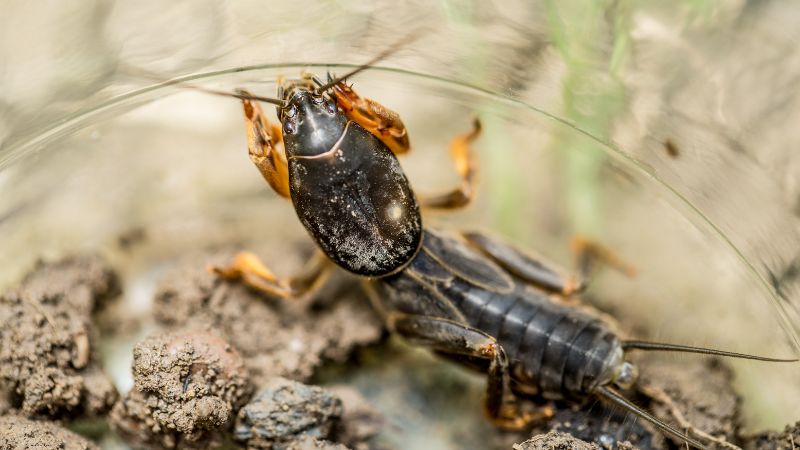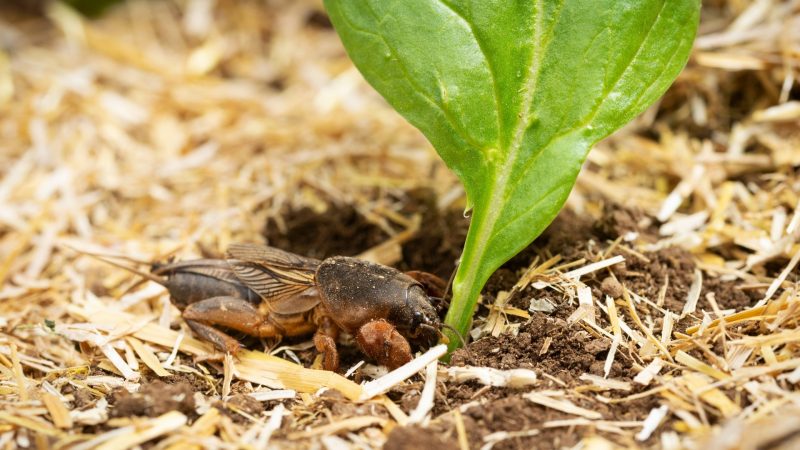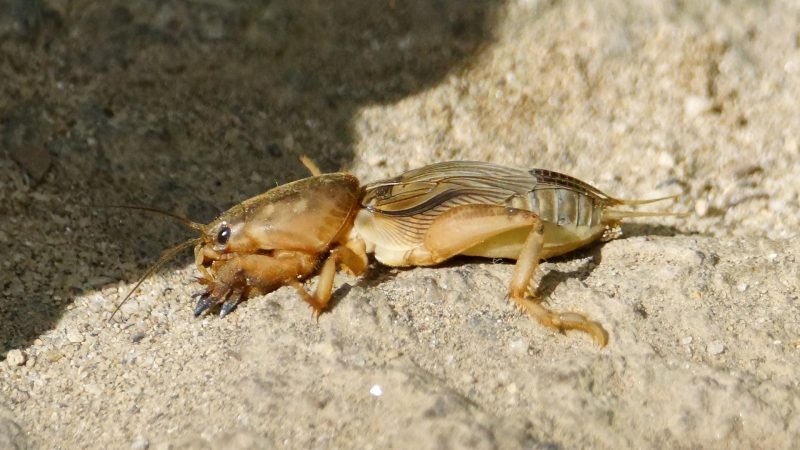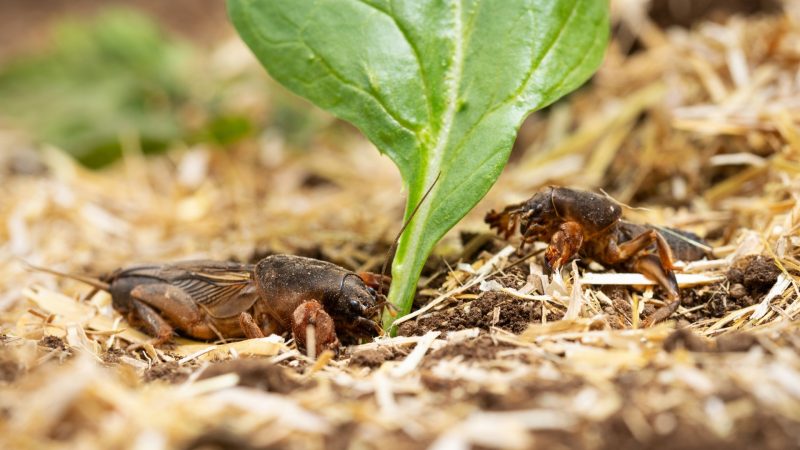Mole crickets generally resemble mammalian moles, but variation in appearance could still be observed, depending on species. Unlike true crickets, mole crickets do not have enlarged hind legs. Rather, they possess powerful forelegs, which enable them to dig tunnels remarkably.
What are mole crickets? Mole crickets are major pests of turfgrasses and various plants as they feed on plant parts above and below ground, while their extensive burrowing dislodges the roots and eventually kills grasses. Both feeding and tunneling habits of mole crickets cause severe damage to various grasses and plants.
This article contains information on distinguishing between native and invasive mole crickets, as well as ways on how to suppress their populations.
What Does a Mole Cricket Look Like?

As their name implies, mole crickets appear like tiny versions of mammalian moles. Similar to other insects, their body has three segments: head, thorax, and abdomen. Most adult species have well-developed wings and have a total body length of 1.30 inches.
Unlike other crickets, mole crickets are poor jumpers. Mole crickets are known for their enlarged front legs that are adapted to digging. Each foreleg has either two or four prominent finger-like claws called dactyls.
They have cylindrical bodies with colors ranging from light yellow to dull or dark brown. Behind the head of mole crickets is a shield-like segment called pronotum, with colors and patterns that vary.
Different species of mole crickets are distinguished from one another by examining their pronotum, wings, and dactyls:
| Species | Pronotum | Wings | Dactyls |
| Shortwinged mole cricket (Neoscapteriscus abbreviatus) | Brown mottled pronotum with dark spots | Forewings shorter than the pronotum; hindwings are covered by the forewings | Two-clawed dactyls; U-shaped dactyl spacing |
| Northern mole cricket (Neocurtilla hexadactyla) | Dark mottled pronotum | Length of wings varies geographically | Four-clawed dactyls |
| Southern mole cricket (Neoscapteriscus borellii) | Dark pronotum with four light spots | Forewings longer than pronotum; hindwings longer than abdomen with rounded tips | Two-clawed dactyls; U-shaped dactyl spacing |
| Tawny mole cricket (Neoscapteriscus vicinus) | Dark pronotum with a central band | Forewings longer than pronotum; hindwings longer than abdomen | Two-clawed dactyls; V-shaped dactyl spacing |
Of these four species, short-winged mole crickets, southern mole crickets, and tawny mole crickets are pests. Northern mole crickets are not considered pests since their population is controlled by their natural enemies.
How Big Is a Mole Cricket?
Depending on species, adult mole crickets vary in length. Refer to the table below for their measurements:
| Species | Length |
| Short-winged mole cricket | 0.87” to 1.14” (22 to 29 mm) |
| Northern mole cricket | 0.75” to 1.30” (19 to 33 mm) |
| Southern mole cricket | 0.98” to 1.26” (25 to 32 mm) |
| Tawny mole cricket | 0.94” to 1.30” (24 to 33 mm) |
What Do Mole Crickets Eat?

In general, mole crickets are omnivores, feeding on both plant and animal matter. Food preference, however, varies upon species:
| Species | Food Preference |
| Shortwinged mole cricket | Herbivorous (feeds on leaf and stem tissues, roots, and tubers) |
| Northern mole cricket | Herbivorous (feeds on leaf and stem tissues, roots, and tubers) |
| Southern mole cricket | Carnivorous (feeds mainly on other insects and other soil-inhabiting animals) |
| Tawny mole cricket | Herbivorous (feeds on leaf and stem tissues, roots, and tubers) |
What Eats Mole Crickets?
Mole crickets are subject to both above-ground and underground predation. Underground predators include ground beetles and assassin bugs. They are preyed upon by insectivorous birds (cattle egrets and sandhill cranes) and insectivorous mammals (armadillos).
For above-ground, amphibians (toads), reptiles (snakes and lizards), birds (owls, mockingbirds, and egrets), and mammals (raccoons and foxes) consume mole crickets.
Do Mole Crickets Fly?

Adult mole crickets possess wings and are capable of flight except for the short-winged mole crickets. As denoted by their name, adult short-winged mole crickets develop wings. However, these wings are small in size, which renders them incapable of flying.
Are Mole Crickets Harmful to Humans and Dogs?

More crickets are not harmful to humans. In fact, in Thailand and some regions in Papua New Guinea, mole crickets serve as components of the local diet, which citizens either deep-fry or incorporate in curries.
On the other hand, crickets are neither poisonous nor toxic to dogs. In fact, crickets serve as an additional protein component in pet food.
Do Mole Crickets Bite?
No, mole crickets do not bite people. Although mole crickets may accidentally invade households through cracks or other openings, they are generally harmless and would cause no damage. Removing them involves simply hand-picking or sweeping them outside.
Do Mole Crickets Kill Grass?

They feed on roots and shoots of turfgrass, pasture grasses, and other plants. Aboveground, mole crickets consume leaf and stem tissues, whereas belowground, they feed on roots and tubers. Most species of mole crickets prefer burrowing or tunneling on sandy and loamy soils, causing significant damage to the roots of plants and grasses.
How to Get Rid of Mole Crickets?
Getting rid of mole crickets would require meticulous actions to ensure that they do not repopulate in your property. Here are a few things you can consider:
Monitoring and Managing
Pouring soapy water on the managed site is one of the most common ways to confirm the presence of mole cricket nymphs and adults. Prepare soapy water by mixing one to two ounces of liquid dishwashing soap in one to two gallons of water. Apply the resulting mixture to about 4 square feet.
In about 3 minutes, nymphs and adult mole crickets will crawl to the surface. If the number of moles observed per 4 square feet area ranges from 2 to 4, then the implementation of control measures is necessary.
Control Measures
Before implementing any control measures, samples should be examined whether they are native or invasive species. Invasive species are easily distinguished from the native ones by the presence of 2 dactyls in their front legs (native species has 4 dactyls).
Natural Enemies
Populations of mole crickets can be controlled by introducing their natural enemies. These natural enemies include predators (ground beetles and assassin bugs), parasites (Larra bicolor wasp and the Brazilian red-eyed fly), pathogens (Steinernema scapterisci), or competitors.
Cultural Control
Cultural control methods are all about making the area less attractive to mole crickets. This includes proper irrigation, fertilization, and mowing. The soil’s nutrients must be maintained; thus, would require testing to check soil fertility.
When irrigating, soil type, season, and temperature should all be taken into consideration as excess water and fertilizer could lead to the formation of spongy mat or thatch, which harbor turf insects.
Mowing the lawn at the proper height would also prevent excessive thatch. Depending on species, the recommended grass heights should not be shorter than:
| Grass | Height |
| Centipedegrass | 1.5” to 2.0” (38.1 to 50.8 mm) |
| Bahiagrass | 3” (76.2 mm) |
| Common Bermudagrass | 0.5” to 2.0” (12.7 to 50.8 mm) |
| Hybrid Bermudagrass | 0.25” to 0.75” (6.35 to 19.05 mm) |
| St. Augustinegrass | 3” to 4” (76.2 to 101.6 mm) |
Chemical Control
Insecticides used to control mole crickets come in liquid or granular formulations. Since mole crickets are active at night, applying insecticide late in the day would maximize its effects. Spot treatment is recommended but it would require careful monitoring of pest occurrence.
Irrigation may also be done before the application of chemicals, depending on the product that you are using. This is done to allow penetration of chemicals up to the plants’ root zone. Other products, on the other hand, would require post-treatment irrigation.
For other product-specific instructions such as dosage and other precautions, it is best to check the label before applying any form of insecticide. Application of insecticides is best done during June to July when mole crickets are still immature.
A list of popularly used product brands with their active ingredients can be found below:
1. Orthene Turf, Tree & Ornamental 97 Spray
- Active ingredient: Acephate
- Application: In golf courses and athletic fields and sod farm turfgrass
- Other products: T&O, Lesco-Fate
- Acephate -- 97.4%
- Orthene 97 WP Turf Tree Ornamental - 1can (.773LB) is the proven...
- Common Rose Pests Controlled: Aphids Japanese Beetle Tent...
2. Generic Talstar for Insects
- Active ingredient: Bifenthrin
- Application: In residential lawns, vegetables, sod farm, golf courses, and athletic fields
- Other products: Menace
- Dependable, long-lasting residual control.
- Non-irritating, no-odor formulation dries with no visible...
- No plant damaging solvents, no known phytotoxicity.
- Compatible with herbicides, fungicides, insecticides and liquid...
3. Bayer Polyzone Suspend Pint Insecticide
- Active ingredient: Deltamethrin
- Application: In golf courses and athletic fields, residential lawns, sod farms, and ornamental nursery plants
No products found.
4. BIOADVANCED Shrub Control Insect Killer and Tree Fertilizer
- Active ingredient: Imidacloprid
- Application: Outdoor trees, container plants, and shrubbery
Bait formulations also work in suppressing mole crickets. However, these are often more effective in mole cricket nymphs than adult crickets. When baits are used, irrigation may be done depending on products to manipulate soil moisture and force crickets to move towards the surface and feed on the bait.
How to Catch Mole Crickets?
Mole crickets are known to attract mates through mating calls (songs) that are unique to the males of every species. This has been the basis in creating audio lure traps (recorded mating calls), which have been used extensively to catch mole crickets, usually for research purposes.
What Is the Best Product to Kill Mole Crickets?
Effective control of mole crickets would require establishing an Integrated Pest Management (IPM) program using a combination of biological, cultural, and chemical control methods.
Starting an IPM program would require the following:
- Knowledge of the life cycle of mole crickets and the management practices that would disrupt growth and development.
- Monitoring of sites to check where pest outbreak occurs.
- Knowledge of damage threshold, management practices, and pesticides that work best in a particular site.
More often than not, hiring a pest management professional would be necessary for creating an IPM. Trained professionals could easily recognize damage and use information that worked best from one site to aid in addressing problems on other sites.
Summary
Mole crickets, as the name implies, resemble mammalian moles especially with the appearance of their enlarged front legs. Unlike other crickets, mole crickets are neither excellent jumpers nor fliers. Rather, mole crickets are underground dwellers. They spend most of their lives underground, especially on light sandy and loam soils.
Significant damage to plants and grasses is caused by both the feeding and tunneling habits of mole crickets. Mole crickets feed on roots and shoots, whereas tunneling exacerbates the damage on roots.
Several control methods (biological, cultural, and chemical) are available to suppress mole crickets. These methods, however, would work best when combined into an integrated pest management program.
List of Sources
Buss, E. A., Capinera, J. L., & Leppla, N. C. (2006). Pest Mole Cricket Management.
Held, D., & Cobb, P. (2016). Biology and Control of Mole Crickets.
Iowa State University. (2020). Mole Cricket.
Kerr, C. R., Leppla, N. C., Buss, E. A., & Frank, J. H. (2017). Mole Cricket IPM Guide for Florida.
- Bed Bug Surge 2025: How to Detect, Prevent, and Safely Eliminate Infestations in Top U.S. Cities - June 18, 2025
- Asian Needle Ants Invade US Homes: 2025 Guide to Identification, Risks, and Effective Control - June 11, 2025
- New World Screwworm Alert: How US Livestock Owners Can Prevent Outbreaks and Protect Herds [Summer 2025 Update] - June 8, 2025


